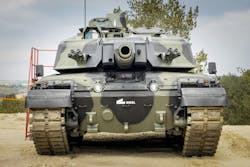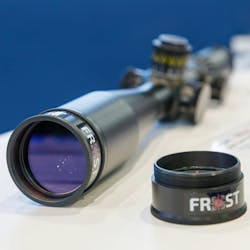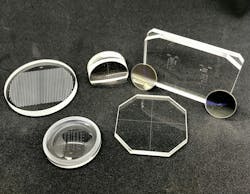See the invisible: Optics and laser threat detection for the battlefield
The modern battlefield is no longer defined solely by conventional firepower. Increasingly, it is shaped by the invisible: Laser-based technologies from rangefinders and designators to dazzlers and directed-energy weapons. For vehicle crews and soldiers on the ground (see Fig. 1), the risk of being detected, tracked, or even incapacitated by a laser is real and growing.
Laser technology is attractive to adversaries because it is fast, precise, and difficult to detect until it is already in use. In recent years, we’ve seen an escalation in the variety and intensity of these threats. Rangefinders that silently acquire a target. Designators that mark assets for incoming fire. Dazzlers that temporarily blind optics or human eyes. And directed-energy systems capable of disabling sensors outright.
Against this backdrop, optical technologies have become frontline tools to protect personnel, vehicles, and mission success. At G&H, we see the next generation of defense not only as stronger armor or larger platforms but as smarter optical systems that can see further, detect earlier, and respond faster.
Beyond vision: Integrating detection into optics
Traditionally, periscopes and sighting systems were designed to maximize clarity and resilience within hostile environments. But clarity alone is not enough when the threat itself is invisible.
That is why we worked with Sentinel Photonics to embed laser detection directly into the optical pathways of our vehicle periscopes. The result is a compact, low-power system that continuously scans for incoming laser radiation to alert crews within milliseconds. Crucially, the integration is seamless: Operators use the periscope as they always have, while the detection system works silently in the background.
This approach minimizes training requirements and ensures legacy vehicles can be upgraded without significant redesign. In other words, we’re future-proofing battlefield optics by ensuring they’re not just windows to the outside world but guardians against unseen threats.
Protecting soldiers: Filters preserve clarity and concealment
Another dimension of the laser threat is the risk to individual soldiers, particularly while using magnified optics such as riflescopes. A laser pointed directly at a scope can dazzle, distort, or in extreme cases, damage eyesight—and retroreflection from the optic itself can even reveal the operator’s position.
To address this, G&H | Artemis, in partnership with Sentinel Photonics, developed the FROST series of filters—rugged optical elements that mount directly onto riflescopes and other magnified sights (see Fig. 2). These filters deliver dual protection to block harmful laser wavelengths while suppressing retroreflection to reduce the risk of detection.
Our solution protects without compromise to enable soldiers to continue maintaining situational awareness even within laser-saturated environments. FROST ensures that “see first, act first” remains an advantage for friendly forces—not adversaries.
Reticles and precision
Precision targeting has always been at the heart of defense optics. Through our most recent acquisition of Global Photonics located in Tampa, FL, G&H expanded its capability to manufacture microlithographic reticles (see Fig. 3) with tolerances as tight as ±0.002 mm.
These reticles are not just patterns etched in glass but act as the interface between operator and target, the fine line that translates a decision into action. By producing them within cleanroom environments and applying advanced coatings, we ensure they withstand harsh use while preserving absolute clarity.
This capability also opens doors to customized designs to enable our customers to adapt reticle layouts for mission-specific requirements—from long-range sniping to advanced fire-control systems.
Integrated solutions: Components to systems
While individual technologies such as filters, reticles, or periscopes each play their role, the future of defense optics lies in integration. Systems must be lighter, smarter, and easier to install across fleets of new and legacy vehicles. They must also be interoperable, able to feed into broader defensive architectures, and trigger countermeasures when required.
Our embedded image periscope (EIP), for example, integrates high-definition electronic displays with relaxed-view biocular optics to enable operators to switch seamlessly between direct and indirect views. When paired with AI-enabled vision systems such as Overview’s PodView 2500, the result is 360-degree situational awareness with real-time analytics—a complete vision solution that protects crews by helping them see what others cannot.
These systems are not about adding complexity for its own sake—they’re about reducing operator burden while multiplying capability. On a battlefield, where every second matters, clarity and speed are decisive advantages.
Partnerships and growth: Building capacity for defense
None of this progress happens in isolation. Over the past two years, G&H has strategically expanded our capabilities through acquisitions and partnerships. G&H | Artemis brought enhanced coating expertise, while Global Photonics expanded our reticle portfolio. Sentinel Photonics has been a vital partner in embedding laser detection across our product lines.
Together, these moves have positioned G&H not simply as a component supplier but as a comprehensive defense optics partner—one that can deliver integrated solutions from design to deployment.
Road ahead
The rise of laser threats is not a passing trend but rather a defining feature of modern and future conflict. As adversaries invest in new ways to detect, dazzle, and disrupt, we must ensure that our forces are not only protected but equipped with superior capabilities.
For us, that means continuing to push the boundaries of what optical systems can do—making them smarter, more resilient, and more integrated than ever before. It means maintaining close partnerships with defense organizations, integrators, and end users to ensure solutions are practical as well as advanced. And above all, it means keeping mission success and personnel safety at the heart of every innovation.
Optics and photonics may once have been seen as enablers of defense, but today they are its front line. At G&H, we are proud to help our customers see the invisible, detect the undetectable, and protect against the unseen threats.
About the Author
Jamie Pindard
Jamie Pindard is executive vice president of optical systems for G&H.


